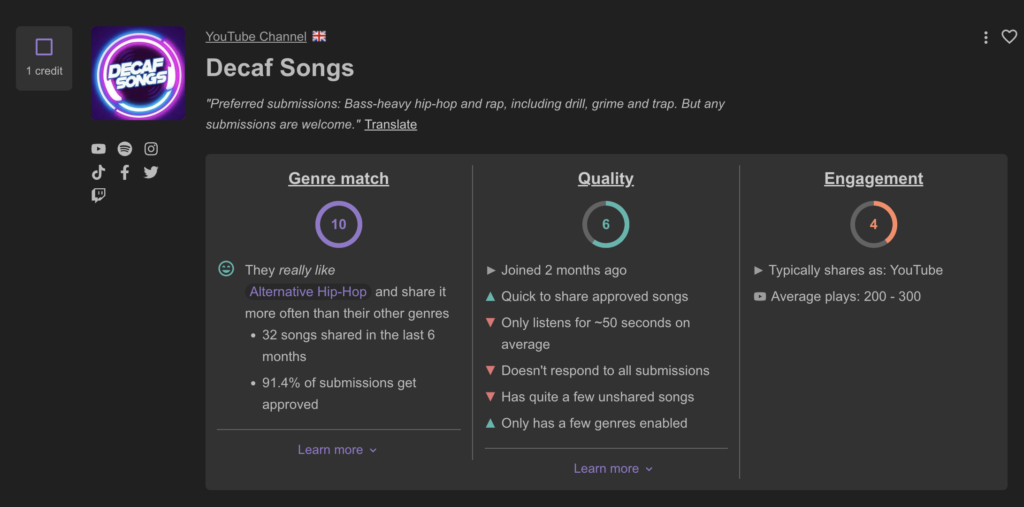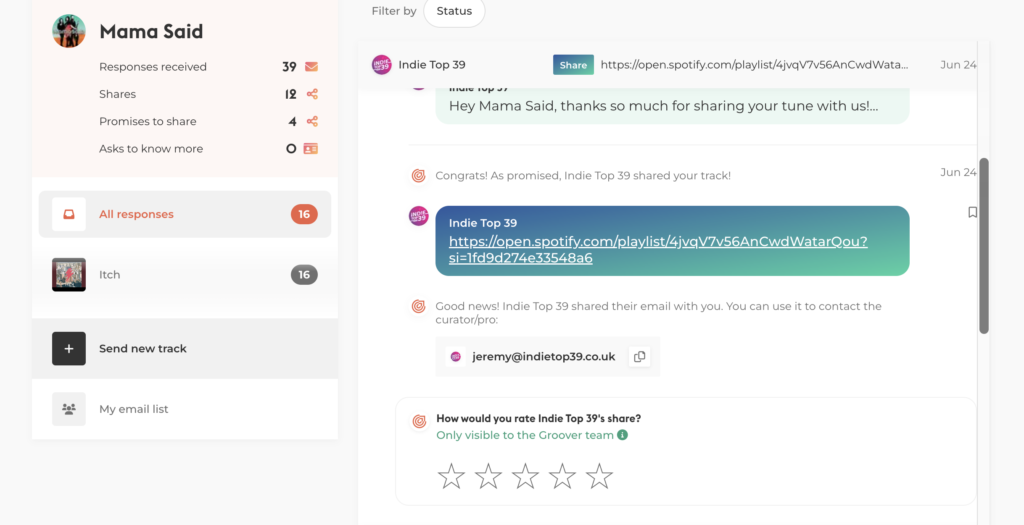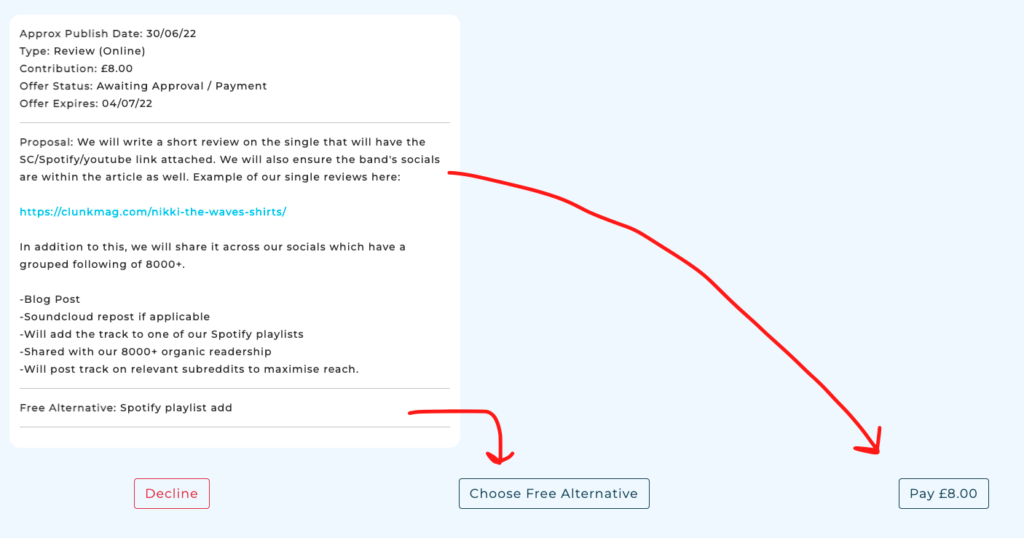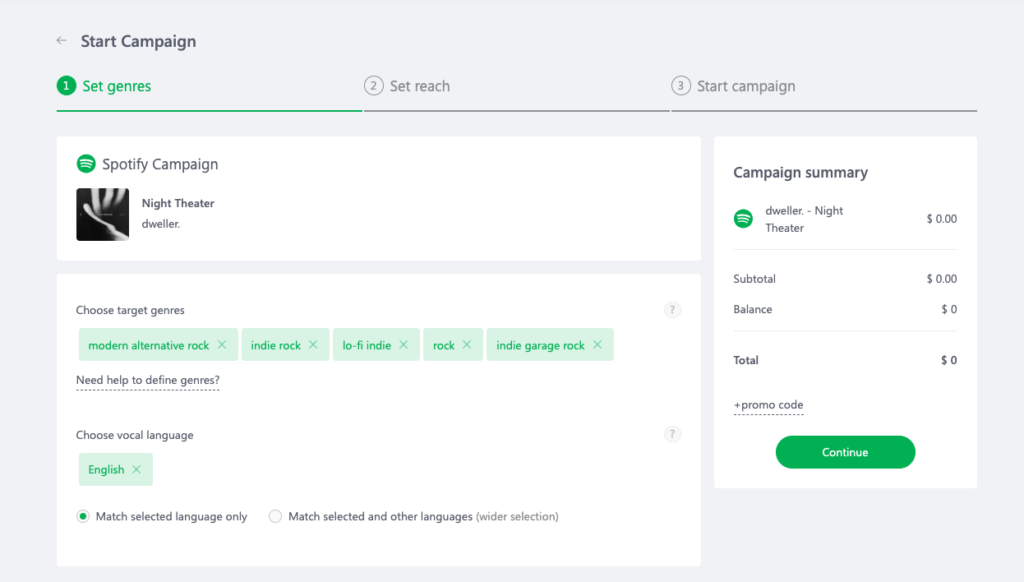Here’s the TL;DR list of music submission sites, curated by someone who’s used all of them this year:
And here’s a quick breakdown, awards-style:
- Most transparent music submission site: SubmitHub
- Best music submission site for getting on Spotify playlists: Playlist Push
- Submission site with the best chance at results: MusoSoup
Okay – if you’re raring to send your music to someone, click one of those links up there and have at it.
But if you’ve got a few moments to stick around and get the details on each of these five options – well, you’re making a good call. I think it’s always better to have a strategy when you submit your music, rather than blasting it out without thought. As someone who gets about fifty music submissions a day, trust me when I say that thoughtless blasting is a good way to a) annoy people, and b) get bad results. Also, it sounds kind of frightening.
On the flip side, if you use these services strategically, you can build real relationships with curators, get meaningful results, and find people who truly care about your music.
All right. With that said, let’s get into it.
First, what is a music submission site?
I want to define my term to get started, because I think that’ll put this list into context. Here’s how I’m defining this:
A music submission site is a place where you can send your music to a bunch of different curators.
Note that I don’t mean a music blog or a label or something, where you can fill out a contact form and send your music to one curator. We’re talking scale, here.
Okay, hopefully that clears things up (and appeases the good folks at all the music blogs who felt angry to be left off this list). With that said, here are the top five music submission sites in 2022.
1. SubmitHub
Jason Grishkoff founded SubmitHub in 2015 “as a way to make the process of sending music to curators as easy and transparent as possible.” As it turns out, that was a great idea.
SubmitHub is pretty much the OG of the sites on this list. I’m not sure if it was the first music submission site; there were a couple of other similar sites founded around this time (HumanHuman, for example), but SubmitHub’s the only one that made it alive and kicking into the 2020s.
And yeah, it really is kicking.
The overall premise is this: SubmitHub lets you submit a song to the specific curators of your choice. They guarantee that curators will listen to your song, but they don’t guarantee that anyone will place it. Submissions costs anywhere from 1-3 credits (and credits cost about $1, depending on how many you buy at once).
For what it’s worth, SubmitHub is pretty much the model that every other music submission site is up against.
Here’s what’s good about it:
It has a very large collection of curators.
Out of the sites on this list, SubmitHub probably has the largest collection of curators on its platform. As of this writing, they’ve got 2,895 active curators, so basically every person on the planet who’s writing a music blog from their bedroom plus a bunch of Spotify playlisters, label people, and radio stations.
The long and short of it is that, if you have any sort of audience out there, there’s a curator for that audience on SubmitHub.
Its interface is very robust.

That’s a screenshot from the submission side of the interface – it’s an overview of a curator profile, and you can see that there’s an insane amount of data associated with each curator. The stuff listed there is only the beginning; if you click this listing to expand it, you can see their “About” section, links to all of their profiles, and more stats on what they’ve shared, including a specific list of songs.
The upshot of this is that, if you take the time, you can get a very good feel for if a curator is actually right for you.
And then there’s the filtering.
That’s a quick scroll down the sidebar to give you an idea. Basically, if you want to pare your list down based on any sort of criteria (i.e., how likely an outlet is to share your song, or outlets listed on Hype Machine, or outlets that share to Spotify, or whatever), you can.
SubmitHub gives you an abundance of data and the tools to sift through it to your heart’s content.
It’s insanely transparent.
Like, painfully so.
First, you get to choose exactly who you want to submit your music to (and you know a lot about whoever you choose, because, again, SubmitHub offers a ton of data on every curator).
Second – and this is the painful part – if you so choose, you get to receive specific feedback from curators, even if they opt not to cover or place your music. You’ll get to see which user listened to your track, how long they listened, and what they said about it.
Most often, they’ll say something inane and then reject you. Take curator responses with a grain of salt; as someone who’s reviewed a lot of music, I can tell you that after an hour of listening to music submissions, everything sounds like mush, and it’s no fault of the artists.
Sometimes, a curator will say something nice and approve you. (This happens around 10-20% of the time, although if your song is the next “drivers license”, maybe you’ll get up to 30%.)
Point is, you’ll always know exactly what’s happening. And while that’s painful at times, it’s also pretty cool.
The drawbacks:
The cons of SubmitHub are the flip-side of its pros:
- Because it has so many curators, it can take a while to find the ones that make the most sense for you
- Because there’s so much data, it takes some skill to run an effective campaign
- Because it’s so transparent, it kind of sucks to use, because you’re going to get a lot of lame feedback that’ll make you feel bad
The bottom line on SubmitHub:
In my opinion, SubmitHub is the best music submission site on the planet. While it’s never fun to run a campaign, it’s usually pretty dang effective.
SubmitHub’s got a ton of curators, it’s insanely robust, and it’s painfully transparent. While it’s not playlist-specific (and, as a result, doesn’t have some of the biggest playlist curators onboard), my recommendation is that, if you’re running a DIY PR campaign, you should give this platform a shot first.
You can check out our full review on SubmitHub here. And if you’re interested in trying a campaign on the platform, you can go for it here (where you’ll get a 10%-off coupon).
2. Groover
I went to college for “marketing” (because I didn’t know what I was doing with my life), and I remember learning about the “second company” phenomenon: Basically, developed markets tend to have at least two major players, with one playing the role of “established and trustworthy,” and the other playing the role of “upcoming cool company / rebel.” Think Coke versus Pepsi, McDonald’s versus Burger King, Verizon versus T-Mobile, or back in the day, Microsoft versus Apple.
You get the idea. There’s always a primary player and an up-and-coming player. Well, Groover is the up-and-coming player in the music submission market.
Here’s what’s good about it:
It’s got a decent selection of curators.
While there aren’t quite as many curators on Groover as there are on SubmitHub, there are still a bunch of curators on Groover. The site currently lists 1,675, which is impressive.
It’s worth noting that Groover is a bit Euro-centric; the company is based in France, and anecdotally, I’ve found that international blogs are more active on the platform. But it does feature a significant number of outlets from other continents, too.
It’s really easy to use.
Think SubmitHub, but stripped down so that things are faster. Groover is more insistent about suggesting curators for you to send to (based on the genres and preference you select), and they don’t offer quite as extensive a range of filters to pare down your search.
The result is that, while you have a little less flexibility in putting a campaign together, things also tend to happen faster. My last Groover campaign took about half the time of my last SubmitHub campaign to set up.
The drawbacks:
There are a couple of issues, which I’ve already kind of alluded to:
- It’s a bit Euro-centric. That’s not a weakness if you’re a European musician, but if you’re not, it’s something to consider.
- Because it’s a bit more stripped down, there’s less customization. This plays out in the filtering, and really, across the whole campaign experience.
For example, you can only specify your genres at the artist-profile level, rather than for individual songs. And you can’t reply in-chat to curator messages – all you can do is rate feedback.

The bottom line on Groover:
Groover is a solid option for submitting your music to curators, especially if you’re a European-based artist. It has a nice network of curators, it’s fairly transparent, and it’s very easy to use.
You can read our full review of Groover here. And if you want to give the submission site a shot, click here, and you can use code TWOSTORYMELODYVIP to get 10% off.
3. Playlist Push
Outside of SubmitHub, Playlist Push probably takes the most flak online. I get it – they aren’t perfect, and they aren’t all that transparent – but after using it a bunch, I don’t think they deserve it.
Here’s the pitch with Playlist Push: They send your music to Spotify playlist curators or TikTok curators – one or the other, depending on what campaign you choose.
That’s it.
You don’t get a say in who, exactly, you get sent to. All you do is input your genre, some meta info, and steer the ship a little bit. Then Playlist Push sends your music off to the people they think you’ll be a fit for.
Here’s what’s good about it:
I think they have some of the best third-party Spotify playlist curators in the world on their platform.
That’s because they’re one of the best platforms in the world for curators. The fact is that SubmitHub, by comparison, pays curators pennies; the most expensive setting as a curator on there is three credits, and you get to keep half of that per submission, which basically comes out to $1.50 per song.
Playlist Push, on the other hand, pays up to $15 per song, depending on how popular and healthy a curator’s playlists are. Over time, that makes a huge difference; if you can process 20 songs in an hour, you’ve made $30 on SubmitHub, but you’ve potentially made $300 on Playlist Push. I interviewed George Goodrich, the co-founder of Playlist Push, and he told me that they’ve had curators pay their way through college using revenue from the platform. Trust me – that is not happening on SubmitHub.
As a result, the curators that have the best playlists usually gravitate toward Playlist Push over SubmitHub. For artists, this means that, when you get on a playlist, you usually see pretty solid results.
It’s super simple.
Again, you’re relying on Playlist Push to find the right fit for your music, and because you’re not selecting curators one-by-one, setting up a campaign takes like 10 minutes.
The drawbacks:
Of course, it’s not all sunshine with these guys. There are several pretty significant downsides to Playlist Push:
- They’re by far the most expensive platform on this list. An entry-level campaign costs over $300 – and I’ve run at least two campaigns where we paid that and got literally no results (because every curator rejected the song).
- They don’t give you much control – you can’t choose who your song gets sent to. If things work out and you get great placements, you probably won’t care, but if you look and see that your song ended up with 10 curators who don’t seem like great fits, you’ll probably feel pretty frustrated.
The bottom line on Playlist Push:
In my opinion, Playlist Push is both the best option on this list for Spotify playlist placements and the biggest risk on this list for returning zero results.
I’ve run multiple campaigns on this platform where we got a bunch of strong placements that led to thousands of plays – and, better yet, led to long-term algorithmic growth after the initial playlist spike. In all honesty, the best playlist pitching campaigns I’ve ever seen happened on this platform.
But I’ve also run multiple campaigns on Playlist Push where we paid $300 and got nothing back. No playlist placements, no streams – just a drivel of useless feedback from curators who didn’t seem like good fits.
So, it’s a mixed bag. I do think it’s worth a shot if you’re looking to get Spotify traction, though – especially if you can bear the thought of risking $300.
You can read our full review of Playlist Push here. You can give the platform a try here, and if you use the code CXUFDQ2 you’ll get 7.5% off.
4. Musosoup
Musosoup is an interesting one; they’ve pivoted furthest from SubmitHub’s model, and the result is both good and bad.
Here’s the premise: Instead of selecting curators to send your music to one-by-one, you pay once and get sent to every curators on MusoSoup.
Curators filter through submissions as on other platforms, but, unlike on other platforms, if they approve your music, they’ll send you two options for coverage: a “free offer” and a “paid offer”. You can choose either option.

Here’s what’s good about MusoSoup:
You’ll get sent to a bunch of curators without having to pay that much.
Admittedly, there aren’t as many curators on Musosoup as there are on Groover or SubmitHub – but there are still over 200, and you get sent to all of them rather than having to pay for each. It’s super cost-efficient in that regard.
You’ll almost definitely get offers to cover your song.
I hadn’t heard of Musosoup before 2022, but over the past year, I’ve run around a dozen campaigns through their platform – and every single campaign has generated at least a few placements.
We’re literally at 100%.
At the top of this article I listed Musosoup as the platform most likely to get your music covered or placed – that’s why.
With that said, Musosoup is fourth on this list for a reason…
The drawbacks
The model is a blessing and a curse.
- You’ll almost always get better paid offers than free offers, which is lame. Curators are incentivized to offer better paid offers, because they make more money from that. I’ve found that most free offers are only for a playlist add, and most of the playlists aren’t great.
- Some curators approve basically every song they get. After running a bunch of campaigns, I saw that the same curators were approving everything I sent their way. I don’t claim to know for sure, but seven submissions in, it definitely feels like they’re only approving music because they’ll get paid for their coverage. And, again, that’s lame.
The bottom line on Musosoup:
As I wrote in my full review on Musosoup, I really do appreciate the heart behind what these guys are trying to do. I just feel weird about the whole “paid offer / free offer” thing.
Now, I have emailed back and forth a bit with Chris, the founder, and he seems like a good guy. I know they’re taking these issues seriously; they recently introduced a submission option where you can choose to only receive free offers for coverage. That’s cool, and I’ll be interested to see how it plays out.
For now, I’ll just say that a) this is probably the best option if you want guaranteed coverage of your music, and b) because of the paid options, I’m still iffy on the model as a whole. That said, Musosoup does work, and you can give it a shot here.
5. SoundCampaign
This is one that I’ve only come to know more recently; the company first came to my attention at the end of 2022, and I tried my first campaign with them in 2023. I didn’t get quite the result I was looking for, but I did come away feeling good about the platform as a whole.
SoundCampaign offers a few different services, but their primary one is Spotify promotion through submission to playlist curators. Functionally, the platform is set up the same way as Playlist Push; rather than handpicking who you’ll send your music to, you pay a flat rate and input some song meta data – SoundCampaign takes care of the rest.
Here’s what’s good about SoundCampaign:
Like Playlist Push, the platform is very easy to use. If you’ve ever tried to use SubmitHub and come away overwhelmed, I think you’ll like this interface better. Campaigns are super simple to create; you just select your genres, set your budget, and hit go.

You have the potential to drive a bunch of streams.
As opposed to playlisting services where you pay for a certain number of streams, with SoundCampaign, you aren’t guaranteed to get any results. But there’s also the chance that, if things go well, you can get absolutely awesome results (whereas, if you pay for streams or a number of placements, you’ll almost never get more than you pay for).
Based on what I’ve seen, SoundCampaign has some pretty significant playlists on the platform, so the potential for an awesome campaign is definitely there.
It’s more affordable than Playlist Push.
Campaigns start at $80. For reference, Playlist Push starts at around $280.
The drawbacks of SoundCampaign:
- The one campaign I’ve run on this platform got mediocre results – we just didn’t get any significant placements. (You can read the full review of that experience here.) Things vary a ton from campaign to campaign, so I certainly don’t take that experience as fully representative of the platform, but it’s still got to be a con.
- They seem to prefer more mainstream genres – at least, the playlists my song was placed on suggest that this is the case.
The bottom line on SoundCampaign:
If you’re looking for playlist placements, this is a music submission platform worth considering. They’re not as established as SubmitHub and Playlist Push, but they’ve done a nice job of developing a network of curators, and their interface is about as easy-to-use as it gets.
If you’re interested in trying SoundCampaign, you can give them a shot here.
6. Submitl.ink
All right, last one on the list: Submitl.ink. This quirkily-named platform is last mostly because it’s very new, and, as a consequence, very small. But it’s on the list because I really like its ethos. It’s by the same people who run Artist.Tools, which happens to be my favorite site for finding playlists and playlist curators. The team is very focused on transparency and usefulness – and I also happen to like their feel for UIs.
Practically, Submitl.ink works very similarly to SubmitHub and Groover, but, like Playlist Push, it’s primarily focused on playlist curators rather than bloggers. You get to select the curators you want to send your music to, and then those curators listen and respond.
Here’s what’s good about Submitl.ink:
It’s well-designed and easy to use.

The wizard’s super straightforward; unlike SubmitHub, it’s not confusing at all ha.
It’s transparent.
Unlike Playlist Push, you get to choose exactly who you’re sent to.
The drawbacks and the bottom line:
I’m combining the drawbacks / bottom line because they’re kind of the same thing in this case – there’s really one main problem with Submitl.ink, and that is that there aren’t very many curators on it yet.
As of this writing, there are 95 playlists on the platform, which sounds like a lot until you consider that there are probably like 1,000x that many on SubmitHub.
When I ran a campaign, I only had a handful of curators that matched my genre; unsurprisingly, we got rejected by all ~5-6 of them. I kind of expected that, but yeah, until the network is bigger, the platform is probably only best for select rap/pop artists.
That said, if you are in those genres, the platform is legit and it’s got a cool vibe. You can read my full review on it here, and if you want to give it a try, you can do that here.
Final thoughts on music submission sites
Hopefully, this list was helpful as you consider how to submit your music to curators.
The sites I’ve listed here are helpful because they let you do music submission at scale. But the downside of that is that you’ll get rejected at scale, too; no matter what platform you use, you can expect to get rejected a lot. That’s the sad reality of things.
There’s just so much music out there, and there’s only so much space for curators to give it. You’ll almost certainly get feedback that literally makes no sense and still somehow makes you feel bad.
Don’t be discouraged. Don’t give up. Your music is worth it, even if some random SubmitHub curator tells you “the vocals were tiny.” (Yes, this level of music criticism is what you can expect to hear.)
Treat these sites as what they are: opportunities to put your music in front of more ears.
Here’s wishing you good luck.








